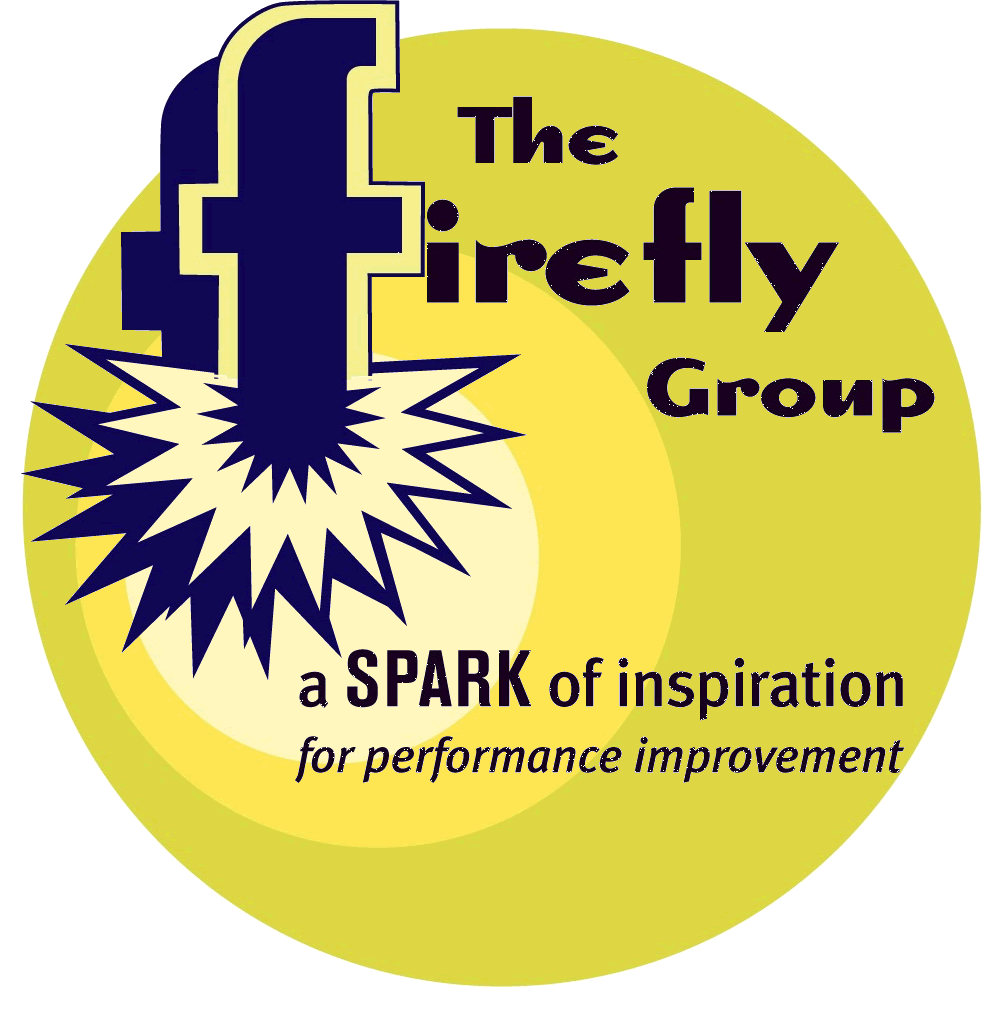

|
|

October 2011
In this Issue: Readers Write about Change Anything
|
Say
It Quick |
Discoveries bits of serendipity to inspire and motivate |
Ideas fuel for your own continuous learning |
Activities tips and tricks you can try today |
| All Together | Stormy Lessons | Self-Organizing Systems | Get the Beat! |
What's the key to coordination amid chaos? It's not control! Learn the secret inthis New Flash by beginning with this 99-Word Story.
All Together
Imagine dining out with a group of life-long friends - a big group - twenty-four
in all! After 5 hours of food and highly spirited conversation up and down
the long table, the woman across from you bursts into boisterous song. Shortly,
the whole table is singing loud enough to rattle the windows.
This is a common experience in parts of Spain but, as a foreigner, I was worried about disturbing other restaurant patrons. Then, to my surprise, all the other diners joined in! People on the street heard us and added their voices too.
Collaboration can be contagious!
 Stormy
Lessons
Stormy
Lessons
In late August, Hurricane Irene swept up the east coast of the U.S. killing
at least 55 people and causing flooding and destruction from the U.S. Virgin
Islands to New England.
Vermont, among other northern states, was especially hard hit by Irene which dumped more than 10 inches of rain in less than a day. The local landscape of steep mountains and narrow valleys presented a dangerous situation with so much rain. Swollen streams became raging torrents that gouged huge sections of roads and swallowed homes as they claimed a new course.
With so much chaos and destruction, you might expect there to be continued suffering while people waited for help to arrive. Yet a sense of order actually developed very quickly. People affected by the disaster didn't wait for state or local officials or even the Red Cross to begin repairs or emergency restoration. Dan DeWalt described the situation in an editorial in the Brattleboro Reformer on August 8, 2011.
"Within an hour or two on Monday morning [the day after the storm], residents had organized a meeting at the Williamsville Grange for that evening to assess what folks needed and what others had to offer. A sandwich board advertising the meeting was erected in front of the Grange and notices were posted by bike along the flood path and the one usable road. No one asked permission to use the Grange, owned by the town, and no one waited to find out if the Selectboard was going to do something. It was clear that action was needed and it was taken. At the appointed hour, close to 100 residents crowded the hall. Two members of the Selectboard were there along with the town clerk.
"The meeting could have easily turned into an unequal exchange of the citizens being instructed by our official leaders, but our elected town officers are better than that. They acknowledged the purpose of the meeting - neighbors reaching out to each other - honored that agenda, and served it well, all the while contributing what they could as town officials."
In DeWalt's description, it was the townspeople, not the town officials, who were the first to respond to the disaster. A similar sequence of events occurred across Vermont communities.
In Wilmington, flood waters raged through the center of the village damaging or destroying every building in the business district. There too, people gathered at a central location to share news and pot luck meals. One person kept a notebook to organize the efforts. The list of people offering volunteer help ran to several pages. But surprisingly, there was less than a page listing people who needed specific aid. Those in emergency need had already received assistance from neighbors! These people didn't need help from official authorities to get themselves organized.
 In
his editorial, DeWalt credits the positive response by local Vermonters to
the chaos to several factors: Concern for neighbors, the ability to assess
local needs, and an understanding that "we all have a job to do to keep the
commonweal functioning and healthy."
In
his editorial, DeWalt credits the positive response by local Vermonters to
the chaos to several factors: Concern for neighbors, the ability to assess
local needs, and an understanding that "we all have a job to do to keep the
commonweal functioning and healthy."
This type of self-help is not unique to Vermont. There is a natural tendency toward organization that can be seen in both nature and in human systems. Just as an ecosystem tends toward balance after the introduction of an invasive species, our human systems tend to reorganize themselves after a crisis. Even very thoughtful plans can fall apart due to unforeseen variables. But people "on the ground" closest to the action often know exactly what to do and how to do it. Long before official help can arrive, they step in to direct traffic around an accident, organize a search for a lost child, or evacuate from a burning office building.
These are all examples of self-organizing systems, situations where good gets done without a specific authority in control and without a pre-determined plan. Self-organizing systems usually develop around a central goal or idea that people share in common such as the notion that my safety is dependent upon yours or that it takes a village to raise a child. DeWalt identifies another concept that can inspire a self-organizing system: the notion that a community is built when everyone makes a contribution.
When people have a strong sense of purpose, they can see clearly what needs to be done, and they can do the work without official direction. Like the restaurant patrons in the 99-Word Story this month, collaboration is contagious.
Self-Organizing Systems
|
For More Information:
|
Business writers such as Fritjof Capra, Margaret Wheatley, and Peter Senge,
have been drawing parallels between phenomena in the natural world and the
ways we structure our human systems for years. The work of these thinkers
has focused on the similarities between organizational life and natural systems
in biology, chemistry, physics, and the environment. These living systems
share several characteristics in common.
They are…
Of these characteristics, "self reference" stands out as especially relevant for organizations. When people know the goal and purpose of an organization, they can use that to prioritize and focus their own activities. It becomes easier to determine what is important or decide whether a new idea is worth perusing. Having strong and consistently communicated values, traditions, aspirations, competencies, and culture all allow the organization to be somewhat independent from the environment. There can be fluctuations at the individual level yet the whole system remains stable.
A recent article about Apple computers in the Christian Science Monitor September 19, 2011, offers an example of the effects of self-referencing in an organization. Apple never cared what the competition was doing. "I'm not sure Apple even thinks about the competition." says Keith Yamashita, a consultant with Apple. "They're uniquely themselves without worrying about anyone else. When I worked for Steve [Jobs] there was little discussion about the competition." (page 31). Apple set the bar for itself and always tried to exceed its own standards and expectations.
Similar to people in Vermont working through the crisis of a flood, employees at Apple achieved consistently high results by staying focused on goals and being true to their values.
Once again, a common purpose makes collaboration contagious.
Get the Beat!
If you would like
to demonstrate the efficiency of a self-organizing system, try this activity
at your next meeting. The larger your group, the better but a minimum group
size of about 12 will still work effectively.
Round One:
Ask people to begin with a round of enthusiastic applause as if they have just experienced the best meeting facilitation ever. Thank them for their participation and ask them to applaud again but with these instructions:"Start clapping again and try to coordinate your clapping into a single, unified, rhythmic beat. Go!"
As the facilitator, do not clap or give any further instruction. Usually, the group settles into a rhythm in short order. Ask people to identify how this happened. Was there a leader? How did people know what to do? Can anyone recall how they chose the particular rhythm to clap? Usually, people have a difficult time explaining how the order crystallized out of chaos.
Round Two:
Invite people to clap once more with these different directions:"Start clapping randomly and enthusiastically as before but this time try to coordinate your clapping into a single, unified, rhythmic beat that is different from the rhythm you used last time."
Again, do not participate in the clapping and do not give any more direction. After a suitable amount of clapping, ask people to describe what happened. In some instances, the group will settle on a new rhythm very quickly. When that happens, ask them to identify how that occurred. Was there a leader? How did people know what to do? Elicit specific examples of how people settled on a particular rhythm.
In other instances the group may struggle for some time before a common rhythm emerges. Ask them to talk about what might be going on. What would help them be successful? (But do not let them make a plan or strategy.)
Round Three:
If the group was not successful or would like to try again, give them another chance with these modified instructions:"Usually groups that do this activity come up with the most interesting rhythm on their third try so I have every confidence that a group of your caliber will be just as successful. You don't need a premade plan or designated leader. Listen carefully to what is happening nearest you and when you hear an interesting rhythm, try to join it and amplify its influence. Go!"
Discussion after this round should focus on what helped people achieve the goal. You will likely get responses that will emphasize some of the following points.
- Having an inspiring goal creates a strong focus for self-organization.
- Listening to those around you is a way to get feedback about your own performance.
- Comparing feedback to the goal is a form of self-reference that keeps the group on track.
When you find your group has got the beat, please your example of how chaos became collaboration!
A Response to the September 2011 Issue
Bonjour, cher ami
A good issue. Your review and discussion of Change Anything was particularly thoughtful and useful.Change is a misunderstood aspect of formal education, or even of learning in general. I used to remind my students that the main result of classes and study would be the change they operated on themselves. If they wanted to remain honkys (?) with a backward cap, a beer, and a hockey game, but with a diploma, they were wasting their time, and mine. Their methods of thinking, even when talking about hockey, their approach to problems, their perspective on the world, even their tastes, would change.
As a criterion, I would tell them that they would have become historians when they had a choice on TV between a Striptease contest and a documentary on the Seven Years War, and they would choose the Seven Years War (in the USA, I think you call it the French and Indian War - we do not call it the English and Colonists War !).
Any learners, class, business, or other, should be advised to watch themselves change as a measure of success. Amitiés --Pierre Corbeil, Montreal
|
If you like what you have read in this issue, I would like to bring the same innovation, creativity, and playfulness to your next meeting or learning event. Whether you need a keynote speaker, or help with strategic planning, performance improvement, or training facilitators and trainers in your organization, I look forward to your call (802.257.7247) or . -- Brian |
Read previous
issues. Click Library!
To add or delete your name to our mailing list, email
with a short note in the subject line.
I want this newsletter to be practical, succinct, and thoughtful. If you have suggestions about how I can meet these criteria, please let me know! Send me an with your thoughts and ideas.
Home
| Services
| Products
| Mission
| Ideas |
The Group
| The Buzz
(c)
2005 - 2011 The Firefly Group